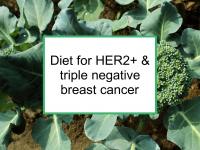The study referenced above was designed to investigate how sulforaphane's efficacy varies according to breast cancer subtype and to examine sulforaphane's actions against breast cancer stem cells. The authors first showed that sulforaphane inhibited triple negative breast cancer growth.
A low concentration of sulforaphane (1 uM) also preferentially eliminated breast cancer stem cells from triple negative breast cancer. (Breast cancer stem cells have the ability to divide indefinitely, thereby driving tumor development and metastasis. Regular cancer cells are the progeny of such stem cells. Limiting the proportion of breast cancer stem cells limits the number of cells that can form tumors.)
On the other hand, the authors found that sulforaphane did not inhibit HER2+ breast cancer growth, even at high doses (over 100 μM). The authors then induced resistance to trastuzumab (Herceptin) (with PTEN deletion and long term trastuzumab treatment) and increased the proportion of HER2+ breast cancer stem cells (by activating a positive feedback loop of IL-6 (interleukin 6) and NF-kB (nuclear factor kappa B)). Sulforaphane was found to have greater than 20-fold higher activity in these trastuzumab-resistant HER2+ cells. Sulforaphane (1 uM) disrupted NF-kB activity and inhibited endogenous IL-6 production by 50%. Using a mouse model of breast cancer, the authors then demonstrated that sulforaphane (at a dosage of 50 mg/kg) reduced tumor formation rate by 70% and inhibited tumor volume by more than 90%. The authors conclude that sulforaphane inhibits trastuzumab-resistant HER2+ breast cancer and breast cancer stem cells by disrupting a NF-kB and IL6 positive feedback loop.
Please see our articles on diet and trastuzumab, HER2+, and triple negative disease for more information.
